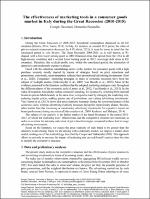Chapter The effectiveness of marketing tools in a consumer goods market in Italy during the Great Recession (2010-2015)
Author(s)
Tassinari, Giorgio
Panarello, Demetrio
Language
EnglishAbstract
In the case of markets characterized by a stationary primary demand, the relevant dimension for measuring a company’s success is represented by market shares. The paper aims to build and comment on a model that gauges the competitive effects of marketing maneuvers on market shares, with reference to tea-based beverages in Italy in the period November 2010 – October 2015. This analysis will be instrumental in establishing the effectiveness of marketing policies based on promotions or advertising. We estimate such a model on weekly data provided by IRI Infoscan and Nielsen, involving the top five brands in the Italian market. After a descriptive analysis and a stationarity test, we estimate a Multinomial Logit model, making use of the Seemingly Unrelated Regressions method. The results allow us to identify the effectiveness of each brand’s marketing policies. Moreover, they enable us to derive the matrices of direct and cross elasticities of brands’ market shares with respect to the main marketing tools (price, promotions, distribution, advertising investments) and to compare basic and average market shares. Based on these results, it is therefore possible to identify the market’s competitive structure, revealing the most incisive factors to be price and weighted distribution, while advertising investments are significant in only a few cases and elasticities are remarkably low. The competitive structure appears to be of a horizontal type (i.e., cross elasticities do not vary greatly).


 Download
Download Web Shop
Web Shop